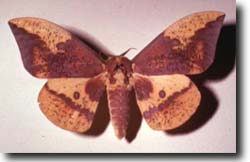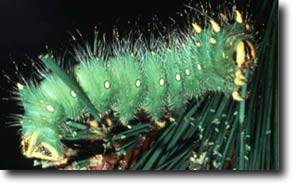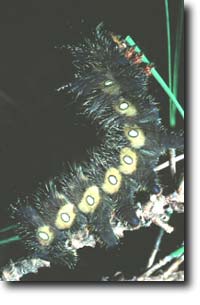The butterflies and moths are probably the most attractive and best known group of insects. Many of us are familiar with some of the large and showy moths and butterflies that grace the forests of East Texas. However, the caterpillars that eventually develop into these beautiful adult insects are not nearly as well known. Here we will consider the caterpillar (larva) and the adult (moth) of the imperial moth (Eacles imperialis). The caterpillar or larva of the imperial moth does not have a common name. This caterpillar can reach a length of four inches, be as big around as a person’s thumb, and appear very intimidating. However, it is harmless. The caterpillar comes in two color phases -- green and dark brown. The green caterpillar has a yellow head with black markings, and several stout, yellow horns just behind the head. The thoracic legs (the true legs just behind the head) are also yellow. The fleshy prolegs (false legs that are lost before the insect becomes an adult) are yellow and black.

The body is covered with long, whitish hairs and a scattering of short yellow spines. The spiracles along each side of the caterpillar appear as a series of large yellow spots rimmed with black and blue. The dark form of the caterpillar is mostly dark brown or dark gray except for reddish thoracic legs and yellow oval with a white center around each spiracle.
The caterpillar is most commonly found feeding on pine, but is known to eat a wide variety of other plants including hickory, persimmon, sweetgum, elm, oaks, maple, beech, cypress, and red cedar. In spite of the fact that this large caterpillar can consume a considerable amount of foliage, it doesn’t cause any significant damage. The caterpillar matures in the fall and that is the time of year when people most often encounter it. When the caterpillar is full grown, it crawls down the tree to pupate in the soil. It does not spin a cocoon, but forms a large naked pupa that is dark brown to black, nearly two inches long, and about three-fourths of an inch in diameter. The tail is pointed and the head is rounded. The pupa will remain in the soil through the winter and the adult moth will emerge in June or July.
The adult stage is the beautiful imperial moth and can have a wingspan of four to five inches. The female is slightly larger than the male. The female moth has bright yellow wings that are covered with red-brown spots. There is a diagonal red-brown line across all four wings. The forewings have two small red-brown circles and each hindwing has a single circle. The male moth is also bright yellow, but has considerably more red-brown coloring. The yellow and red-brown color pattern in both sexes can be variable. Both sexes are attracted to lights at night and that is a good place to look for them.
If one should happen to find a caterpillar, it is not difficult to rear it to the moth stage. If a caterpillar is found still feeding on the host plant, place the caterpillar, along with some host plant foliage, in a large container (one to two gallon size). Each day, fresh foliage should be provided for the caterpillar. It would be good to place two or three inches of loose, moist soil in the bottom of the container so the caterpillar will have a suitable place to pupate when the time comes. If the caterpillar is found on the ground, chances are it has completed feeding and is searching for a place to pupate. In this case, place the caterpillar in a container with soil (as described above) and before long it will probably change to a pupa. If kept indoors, a beautiful imperial moth may emerge during the winter. Sometimes the imperial moth caterpillar will be attacked by a parasitic wasp or fly. Since the larva of the wasp or fly usually feeds inside the body of the caterpillar, it may not be obvious that the caterpillar has been parasitized. A parasitized caterpillar may pupate, but rarely survives to become an adult moth.
 |  |
The larva or caterpillar of the imperial moth occurs in two color phases. This intimidating but harmless caterpillar will eventually become a beautiful moth. (As pictured at top of page.)